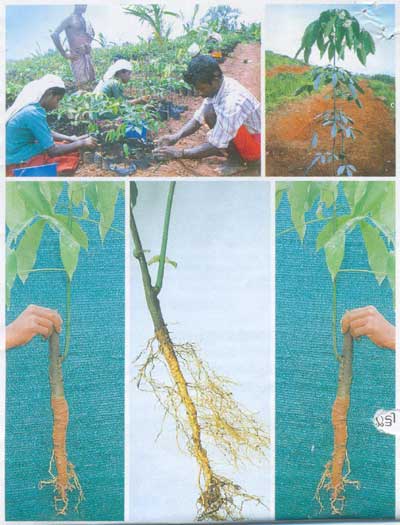Propagation of rubber by budding
K C Kuriakose (71) lives in Karimpuzha panchayat in Palakkad district, Kerala. His formal education ended with failure in the 3rd standard. Ever since he has learnt at the school of life. Farming has been his passion and his wife and four sons share his interest. There have been disputes about Kuriakose’s claims to be the original innovator of the technique. However, The Rubber Research Institute of India vide their communication dated Feb 23, 2004 have commended the improvements made by Kuriakose in young budding technique highly and have endorsed his claims.
Genesis Kuriakose started the Cheerakuzhy Rubber Nursery in 1979. At about this time he came across the budding technique in a magazine and decided to teach himself by experimenting on rubber plants. Consequently during the 80s Brown Budded plants were distributed on a large scale from his nursery. In 1994 he started experimenting with different kinds of budding. Initially he tried planting seeds directly in polybags and brown budding was done in them but this turned out to be unprofitable. Then he tried green budding (developed by the Rubber Board) in which budding was done on three month seedlings in polybags but it was also not viable due to very low budding success. He persisted with different materials and methods and found that budding using buds from tender shoots of about 20-25 days old was very encouraging. Thus after a series of experiments and observations he was able to standardize the technique in 1997 and termed it as Young Budding. Initially people were hesitant to buy this new variety so he gave 10 free plants to everyone who bought rubber saplings from his nursery.
Advantages
Budding success in Young Budded plants is 95-98% whereas in Brown Budding it is only 60-80%. In the Young Budding technique, the root system remains more or less intact which ensures better growth and helps the trees resist strong winds and also gives them greater protection against drying out in the initial years. In Brown Budding, roots are cut back during planting which retards the growth. In the case of the traditional method of brown budding, the budding is done after the seedlings have grown the nursery for one year and they remain in the nursery after budding for another six months. Then they are removed from the ground and transplanted into polybags. After six more months they are ready for planting. So in effect it takes about two years for seedling to become ready for planting using this technique. Whereas in Young Budding the seedlings becoming ready for planting within 10 months.
Young budding saves labour as well as costs. As the plants remain in the polybag, during the entire process, the labour of transferring them from the nursery to the polybags as required in Brown Budding is eliminated. Similarly space requirements are cut down by two-thirds and about two years are saved in terms of tapping Young Budded plants become ready for tapping in five years as compared to the seven or more of Brown Budded plants.
Young Budding according to Kuriakose is particularly women-oriented as the budding is done on delicate seedlings which require patience and a gentle touch, both qualities which he attributes to women. As the saplings become ready for planting in 10 months, women are also able to handle the loading of the plants etc, and he proudly proclaims that about 90% of the employees at the Cheerakuzhy nursery are women. Gender disparity in wages is also addressed to an extent as for budding both men and women get the same wages whereas this is not the case in other kinds of agricultural labour. This assumes importance especially for women from the lower economic strata, as over the years he has seen that in such families, women are the major contributors to household income.
Awards and accolades
Initially on taking a sample of a Young Budded sapling to the Rubber Board, Kuriakose remembers that they were not prepared to acknowledge that budding could be done at such a young stage. So he left an application with the Rubber Board mentioning that he had used this technique of Young Budding successfully. As a result officers from Rubber Board Research visited the nursery. Later, he has received all possible guidance and support from the Kottayam Rubber Research Institute.
In honour of his contributions to the agricultural sector and with special reference to the development of and improvement in the Young Budding technique, Kuriakose was awarded the prestigious Karshakashri award 1998, instituted by Malayala Manorama, a leading daily in Kerala. In 2000 official recognition came from the Rubber Board when the Publicity Deputy Director visited the nursery and published a report on Young Budding in their magazine. Following this the Director of the Rubber Research Institute and other scientists came to the nursery and after detailed observations purchased 5000 Young Budded seedlings and distributed it in 10 regions in Kerala for comparative studies with brown budded plants.
Kuriakose specially mentions the Rubber Production Commissioner, Dr.A.K Krishnakumar, who visited the nursery in 2001 and declared that this technique is a great step forward in the development of the rubber industry. He also issued a certificate to Kuriakose stating that this new technique has provided satisfactory results. Keenly interested in popularizing the technique, the Commissioner arranged a two day training session for 15 nursery owners from various parts of Kerala at Cheerakuzhi nursery. Later a team comprising the Chairman of the Rubber Board, the Research Director as well as the Vice Chancellor of the Kerala Agricultural University visited the nursery and recommended widespread use of this technique. A recognition that holds pride of place in Kuriakose’ memory is the time he was invited to present a paper on Young Budding at the Rubber Planters’ Conference held at Kottayam in 2003 to celebrate the 100th anniversary of Rubber cultivation in Kerala. This paper was later published in ‘Rubber Planters Conference India 2003’, released by the Rubber Board. From 2002 onwards, due to the increase in demand, bookings for Young Bud plants started a year in advance. From 2003 franchises of Cheerakuzhi Young Bud nurseries have been started all over Kerala. Young Budding also has got a lot of mileage on the media-with newspapers, a radio station and a cable channel running features on it.
71 and going strong
At 71 Kuriakose wishes to continue making innovations and contribute in his way to the agricultural sector which he believes is the backbone of our economy. He points out that in a scenario where labour costs are increasing and labourers are difficult to find, the agricultural sector will not be able to progress unless steps are taken to reduce its dependence on labour.
Kuriakose also declares that he has other ideas up his sleeve. One idea, of reusing waste water for agriculture, is still in the infancy stage. He goes on to relate another instance of an innovation in which he improved the performance of a power tiller and took it to a nearby engineering college, where he was told that such small machinery was of no interest to them. Not giving up, he found an opportunity to attend a meeting at the college at which the Vice Chancellor was present and spoke up saying innovations by ordinary people should be encouraged. Accordingly the Vice Chancellor asked someone from the college to come and look at it, but nothing has come of it so far. Kuriakose’ belief in the ordinary man and his potential was echoed by the Rubber Production Commissioner when he had visited the nursery and Kuriakose proudly quotes him, “It is from the ordinary people that all great discoveries and inventions have come. You can ignore them only at your expense.”
What makes this ordinary gentleman, extra-ordinary is his willingness to share his knowledge with everyone. He says,“A lamp should not be hidden under a pot depriving others of the benefit of its light.” His son remembers that when the Production Commissioner had wondered whether Kuriakose would have any qualms in making his discovery free for the public, his father had immediately replied that he would not even be able to meet the demand for Young Bud plants in his own district and wishes to train as many people as possible in this technique since according to him his contribution becomes worthwhile only when widely used.
Young budding is an economically viable technique which can be applied on a commercial level as a method of vegetative propagation in rubber. High quality seeds are planted in polybags during July-August and budding starts from the 28th day and can continue up to the 60th day. The bud sticks are 20-25 days old. After 15-20 days budding success is assessed and the plants are retained in polybags for 5-6 months. The stock plant is cut back at 8-10 cm from the bud patch during January and after 10 days a new plant starts growing. About two gram of NPK mixture in liquid form is applied monthly apart from regular watering. Four months after this the saplings are ready to be transplanted to the field.








